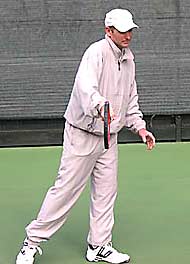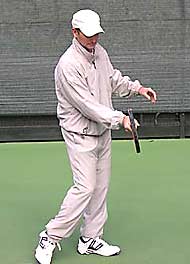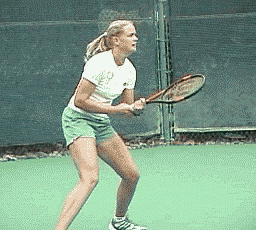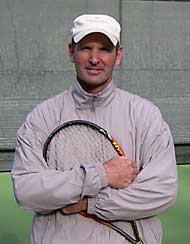|
TennisOne QuickTips
Getting Your Body Into the Shot
By Doug King The most critical point of any stroke is the moment the ball and the strings collide - the contact point. Footwork, racquet preparation, watching the ball are all important but only because of how they affect the contact of the ball. Two important aspects of a good contact are racquet alignment and racquet stability. The more stable the racquet at contact the more power will be delivered into the shot as vibration of the racquet dampens the power of the shot. Hitting the sweet spot is one way to minimize vibration. The other is to properly position the body so that it is acting as a support system for the racquet and wrist. This increases power by reducing vibration at contact and by adding more mass to the object (racquet) that the ball is colliding off of (imagine hitting with a heavier racquet - more power, right?).
The correct position of the body for maximum support is slightly behind and close to the handle of the racquet. Look at Barry Bonds, Tiger Woods, or Andre Agassi and you will see a similarity in the way the body is positioned to the hands to create a solid connection between the body and the wrists (right ear tucked towards right shoulder, upper body slightly back). The most common mistakes are leaning the upper body too forward and extending the arm too far away from the body. In most mistakes the body moves forward too soon only to have the arm swing against the ball after the weight shift. This results in a loss of balance and timing, and a weak, slapping hit.
The arm should remain solidly intact (although not stiff) with the right side of the body (the “hitting side”) and drive (accelerate) in unison with the right side through the contact of the ball. This way the body supports the wrist and the body and the arm work as a unified force against the ball. Proper balance, footwork, weight shift, grips, timing, and strength are all related to establishing a more solid hand and wrist at contact. Hitting off the right foot on the forehand, delaying the weight shift until the actual “drive“ of the ball, gripping more behind and under (semi-Western) instead of on top (Eastern or shake hands grip) are all ways of helping to get the body more “into” the shot. Remember, the body gets “into” the shot through the back face of the handle of the racquet, so position your body slightly behind your arm and then drive both your arm and right side together through the shot for maximum results. Your comments are welcome. Let us know what you think about Doug King's article by emailing us here at TennisOne.
Known for his incisive stroke analysis, Doug is the founder and director of Holonetics, a teaching program at Meadowood that translates classic teaching principles into today's playing styles, creating a new teaching model that helps players of all levels to maximize their skills. |
|||||||




